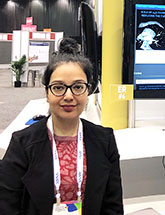Researchers Analyze Impact of 24/7 Emergency Room Radiology Staffing for Brain CT
Of the more than 90,000 patients who enter the Emergency Room (ER) at Vancouver General Hospital (VGH), British Columbia, each year, more than 55 percent arrive outside the 8 a.m. to 5 p.m. timeframe when radiologists are available.
BY NICK KLENSKE
January 29, 2019

Jalal
Even though the majority of these patients require urgent medical imaging, they must wait for the on-call radiologist to arrive. In a life-threatening situation, this delay could have critical consequences. Thus, the question arises: should ERs be staffed with 24/7 onsite radiologists?
In search of an answer, Sabeena Jalal, MBBS, MSc, a research fellow, and Savvas Nicolaou, MD, head of Emergency & Trauma Radiology at VGH, studied the impact of a 24/7 onsite staff radiologist on turnaround times (TAT) for CT brain scans at the hospital, where specially trained staff radiologists are onsite all day, every day.
“The quality of care should not depend on the time of day the patient arrives, as patients suffer from life-threatening conditions all hours of the day,” said Dr. Jalal during an RSNA 2018 session.
The retrospective study utilized data extracted from the hospital information system (HIS) for all consecutive patients requiring a CT brain scan before and after the 24/7 onsite radiologist model was implemented. The pre-24/7 period ran from March 30 to Sept. 30, 2013. The post-24/7 period ran from Sept. 30, 2014 to March 30, 2015.
Analyzing Turn Around Time
During both periods, researchers studied two TATs: TAT-1 is the difference between the time an exam was completed and the time it was transcribed; TAT-2 is the difference between the time the exam report was transcribed and the time the radiologist finalized the report. From this data, researchers tallied the median time for both TATs.
For TAT-1, the pre-24/7 group had a median time of 578 minutes, or about 10 hours, compared to just 54 minutes for the post-24/7 group. For TAT-2, the pre-24/7 median time was 1,577 minutes, approximately 26 hours, compared to 121 minutes for the post-24/7 group.
In addition, the odds of having a significantly lower TAT with 24/7 onsite staff radiologist coverage was 3.46 times higher compared to the TAT when no 24/7 coverage was provided.
“This study shows that having 24/7 on-site staff ER radiologist coverage has a significant impact on reducing turnaround times for CT brain scans, which are usually done to aid in deciding whether an acute medical or surgical intervention is needed,” Dr. Jalal said.
But this study is more than just theory. Since VGH implemented 24/7 radiology in its ER, Dr. Jalal says that data already shows improvements in quality of care and patient length of stay, and could also result in significant cost savings.
“The system prioritizes acute patients, improves report turnaround time and eliminates discrepant preliminary reports,” Dr. Jalal said.